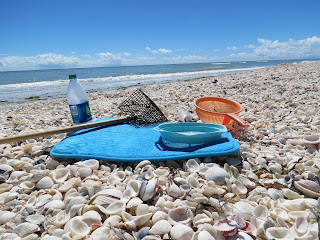The beaches I most often visit are on the gulf coast, near Ft Myers, Florida. Sanibel Island is my favorite, but there are lots of beaches in the Ft. Myers area that have great shelling opportunities.
The first thing you have to understand is that there is no ONE beach, or ONE time of the day, or ONE time of the year that is better for shelling. The tides come in and out, the wind blows east, the wind blows west, the water temperatures and currents continually change, so you can't easily predict where the best places are to find shells. If they were easy to find, they wouldn't be such special treasures!
I do know that the best time is right around low tide. About an hour before the lowest tide, and for about an hour after. You can find tide charts online, and depending on the phase of the moon, the tides are higher or lower, often going into negative numbers. Negative tides are a great time to see varies live shells, sand dollars and star fish. NEVER take a shell that has the live creature in it!
Now that we've got that said, you will need some basic tools and supplies.
A beach umbrella and a chair: You will want to take a break on occasion, and have a shady spot to sit and sift through your finds. The best way to install a beach umbrella is to use a hand shovel to dig a hole 6 to 8 inches deep. Then screw the base of your umbrella into the bottom of the hole. Fill it back in about 1/2 way, then pour some water in the hole. Then add the rest of the sand, tamp it down with your foot, add a little water, and mound some more sand around the base, then tamp it down with your foot. That umbrella won't go anywhere!
Now a lot of times, especially on Sanibel beaches, you will find large piles of shells, sometimes 5 to 6 inches deep. This is one of the least taxing ways to shell. I purchased a small bath matt, with rubber backing and some thin memory foam. It makes sitting on that pile MUCH more comfortable. I use my hand shovel to dig around in the pile. The top may be picked over by other shellers, but I find all kinds of good shells several inches down. The sandbox sifter and kitchen colander are often helpful if you are sifting for very small shells. Bring water and sunscreen!!
That is my friend's walker, made especially for the beach with
big balloon tires and a seat!
If you aren't finding piles of shells, its time to walk the beach. Often there is a high tide line with varies shell pieces and sea weed. Use your shelling rake (the black basket on a stick in the picture above) to move the seaweed around and to uncover the half buried shell pieces you find. Often those "pieces" are nice shells buried in the sand, and seaweed often has shells caught up in the debris.
Pick through the high tide line
This treasure was found under the sea weed
but alas, he was alive, so I put him back into the water
Among all those white, common shells, are some treasures. Click on the pictures to enlarge them and do some cyber-shelling to see what you find! It pays to dig around!
So while its a bit like looking for a needle in a hay stack, but with some patience and time, the sea will reward you with beautiful, one of a kind shells!
This man found this shell in about 3 feet of water, feeling around
with his feet. I had shell envy, so I got in the water and started feeling around
with my feet. I found this big guy!
But alas, this one was still occupied, so after the photo
opp, back in the water he went!






















No comments:
Post a Comment